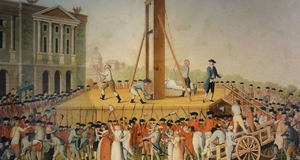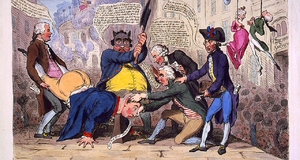Napoleon Bonaparte's Peak of Military Success: Ulm and Austerlitz
By
2012, Vol. 4 No. 09 | pg. 1/2 | »
KEYWORDS:
“There are in Europe many good generals, but they see too many things at once; as for me I see only one thing, namely the enemy’s main body. And I try to crush it, confident that secondary matters will settle themselves” - Napoleon Bonaparte
Napoleon Bonaparte is considered one of the greatest military minds in the history of warfare. When Napoleon Bonaparte launched into a long series of wars known as the “Napoleonic Wars” with Europe in 1799, he was determined to extend the territorial boundaries of France and its revolutionary borders. Historians view the “Napoleonic Wars” as a continuation of the wars sparked by the French Revolution of 1789, which had significant impact on all of Europe and revolutionized European armies. With the modern creation of mass conscription, the French Empire quickly grew, as Napoleon sought to create a universal hegemony over all of Europe. So what was the peak of Napoleon’s military success during the Napoleonic Wars? Napoleon’s road to success was charted by the supreme triumphs of Ulm and Austerlitz in 1805. These battles represented a strategic turning point for the French, and demonstrated the supreme military might of the French Empire and strategic genius of Napoleon Bonaparte. These two battles represent the climax of Napoleon’s success, and signify his continued efforts to expand his empire further into Europe. After failing to carry out his planned invasion of England in 1803-1805, Napoleon led his Grand Armee from the English Channel to the Rhine in order to deal with new threats there.1 The Prussians were mobilizing quickly, the Russians were only a few weeks away from the central European theater, and Austrian forces were within striking distance of Napoleon and his Grand Armee. Napoleon knew he needed to defeat the Austrian force if he was to stand a chance against the entire coalition. An Austrian victory could delay the French until the Russians arrived, prolonging the war and increasing the likelihood that Prussia would enter the war. However, a French victory would defeat the Austrians, scare the Prussians, and leave only the Russians to deal with. The Austrian Army had about 59,000 Infantry and 13,000 Calvary ready to meet the French.2 Napoleon had about 170,000 Infantry and 38,000 Calvary.3 As they prepared for battle, Napoleon deployed the majority of his army along the Rhine River, while the fifth corps and cavalry deploy behind the Black Forest. Austrian General Karl Mack deployed west of Ulm and awaited a Russian army numbering 100,000 that was slowly marching west. As he deployed his troops, Bonaparte made plans to circle the Austrians to prevent any link up with the Russians. Napoleon noticed that he had misdirected his enemy’s attention and was now playing on General Mack’s expectations of a French Invasion through the Black Forest in Southern Germany. As part of that expectation, Napoleon sent his brother-in-law, General Marshall Joachim Murat, with his Calvary into the Black Forest. Napoleon knew that creating a diversion would confuse his enemy and give him the upper-hand in battle. As Murat’s cavalry approached the Black Forest they began to blow trumpets and act like the main army, while preventing Austrian patrol forces from breaking up the brigade. Fifth corps stood by just in case this force came under direct attack by General Mack. Napoleon then ordered the rest of his men towards the Danube River to cut off Mack’s retreat.4 Each brigade was given a specific and exact location, but was allowed to reach their destination anyway they saw fit. However, the forces were careful not to overlap paths on the battlefield. This brilliant strategy can be given credit to Napoleon’s Maxim “separate to live, unite to fight.”On October 1l, 1805 Napoleon’s forces begin to cross the Danube River and surprised the Austrian detachments guarding the river. This act of courageous boldness muddled General Mack’s awareness, and left him confused. At this point, General Mack continued to be unresponsive to the situation taking place around him, and Napoleon slowly gained a tactical edge. Meanwhile, Murat’s Calvary exited the Black Forest and began to scout Mack’s positions. The scouts were confident that he was concentrating his army near Ulm. This intelligence was then reported to senior military commanders and word got back to Napoleon. Napoleon then pressed his left wing to complete the encirclement of Mack by allowing his forces to flood the riverbank where the Austrians were located, overwhelming them. Napoleon then considered the possibility of General Mack retreating, but he was not sure whether the bulk of his forces were fully concentrated at Ulm. Bonaparte ordered Commander Michel Ney and his VI corps to chase away any forces located there and pursue south. Ney’s assault was repulsed and Napoleon was fully aware and understood that he needed to strike before General Mack could escape. General Mack was now cut off from any form of escape and was forced to withdraw to Ulm and devise a new means of escape. Napoleon then assigned I, III and Bavarian Corps to cover the east from any Russian appearance. This strategic act began to cast a net around Ulm, and Napoleon then commanded that V corps and Murat’s Calvary join VI corps in blocking the east, while II and IV Corps block the south. Napoleon finally closed in, encircled General Mack and demanded his surrender. General Mack surrendered his army at Ulm on October 20, 1805. Austrian casualties totaled more than 60,000 men while Napoleon lost no more than 2,000.5 The Ulm Campaign is one of the greatest examples of Napoleons military brilliance and tactical supremacy on the battlefield. It shows his cunningness and determination to defeat his enemies. The victory at Ulm was a product of hard work, long training and preparation that resulted in a decisive victory.6 On the October 21, 1805 Napoleon issued his victorious proclamation: Soldiers of the Grande Armee: Of the hundred thousand men who composed that army, sixty thousand are prisoners; they shall go and replace our conscripts in the labours of our fields….Soldiers, this success is owing to your unbounded confidence in your Emperor, to your patience in enduring fatigues and privations of every kind…. But we shall not stop there; you are impatient to commence a second campaign. That Russian army, which the gold of England has brought from the extremities of the earth, shall share the same fate.7 Napoleon was on a major campaign and he was winning. After the Campaign of Ulm, Napoleon and the French captured Vienna and made their way to Austerlitz, the most successful military battle of Napoleon’s career. The battle of Austerlitz represents the peak of Napoleon’s success. He defeated the third collation, knocked Austria out of the war, and expanded French dominance over the European Continent. After the Austerlitz Campaign, only Great Britain would remain opposed to France. The Battle of Austerlitz took place December 2, 1805 in the present day Czech Republic. Austerlitz is known as the battle of the three emperors, pitting Tsar Alexander I of Russia and Emperor Francis I of Austria, against Emperor Napoleon of France.8 On December 1, the Russian imperial army and the Austrian imperial Army (Allied forces) met with one another to decide the best course of action against the French. Alexander I wished to attack the French head on, but the Austrians wanted to take more of a defensive approach against Napoleon. With intense pressure from senior commanders, supreme allied commanders decided that an attack would be made against the French southern flank.9 However, Austrian and Russian forces did not plan on Napoleon being one step ahead of them. He anticipated they would strike at his right and he thinned it to make it seem a weak spot. This would weaken the allied center and allowed Napoleon to implement a planned massive counter-attack in this area to shatter the allies’ lines. Positioning Marshal Jean Lannes's V Corps near Santon Hill at the northern end of the line, Napoleon placed General Claude Legrand's men at the southern end, with Marshal Jean-de-Dieu Soult's IV Corps in the center.10 As the battle began around 8:00 am on December 2, the first of the allied attacks began hitting the French near the village of Telnitz. The French were pushed back, but the arrival of Marshall Louis Nicolas Davout’s III Corps helped them regain their lost position. However, the French again were pushed away from this position by allied Calvary. With constant fighting back and forth, the French managed to successfully recapture village, but then lost it again. Around 8:45am Napoleon summoned one of his generals to discuss attacking the enemy lines atop Pratzen Heights.11 Stating that “one sharp blow and the war is over,” Napoleon commanded that the attack commence.12 Advancing through the fog, General Louis de Saint-Hilaire's division attacked the heights, but was pushed back by the allied forces. French forces then attempted to charge at the heights again and managed to capture it. As the battle continued the French forces were able to force the Russians to retreat on all aspects of the battle field, and the allied lines began to fall apart. General panic seized the allied army and it abandoned the field in all possible directions. In three months, the French had occupied Vienna, destroyed two armies, and humbled the Austrian Empire. Austerlitz set the stage for a near-decade of French domination of the European continent. On the evening of the victory Napoleon delivered an inspiring speech to his soldiers: Soldiers, I am pleased with you! You have, on this day of Austerlitz, justified all that I looked for from your fearlessness. You have adorned your eagles with an everlasting glory. An army of 100,000 men, under the command of the Emperors of Russia and Austria, has been, within less than four hours, cut to pieces or disbanded. Those which escaped your blades are drowned in the lakes. Forty battle flags, the standard of the Russian imperial guard, 120 artillery pieces, twenty generals, and more than 30,000 prisoners, are the results of this day for all time renowned. This infantry so vaunted, and in numbers superior, could not resist you, and henceforth you have no rivals from which to fear. Thus, in two months, this third coalition has been vanquished and disbanded. Peace cannot be far away; but, as I promised my people before crossing the Rhine, I shall make only that peace that will give guaranties to us and rewards to our allies. Soldiers, when the French people placed the imperial crown upon my head, I entrusted myself to you to keep it forever in those rays of glory which alone make it worthy in my eyes. But at that same moment, our enemies thought to destroy and dishonour it! And this crown of iron, conquered with the blood of so many Frenchmen, they wanted to compel me to place it upon the head of our most cruel enemies! Rash and senseless endeavor, which, upon the very anniversary of the crowning of your Emperor, you have dashed and confounded. You have taught them that it is easier to defy and to threaten us, than to defeat us! Soldiers, when all that is necessary to assure the happiness and prosperity of your fatherland has been accomplished, I shall bring you back to France. There, you will be object of my most tender care. My people shall greet your return with joy, and it will be enough for you to say "I was at the Battle of Austerlitz," that the reply shall be, "Here is a brave man."13 Austerlitz was Napoleon’s peak of success; it effectively ended the Third Collation and forced Austria out of the war. Austria made peace with the Treaty of Pressburg and paid 40 million francs. The remains of the Russian army withdrew east, and Napoleon abolished the Holy Roman Empire and established the Confederation of the Rhine as a buffer state between France and Prussia.14 French losses at Austerlitz numbered 2,000 killed, 7,000 wounded, and 573 captured. Allied casualties were massive and included 15,000 killed and wounded, as well as 12,000 captured.15 These battles represented a strategic turning point for the French, in the Napoleonic Wars, and demonstrated the supreme military might of the French Empire and strategic genius of Napoleon Bonaparte. These two battles represent the climax of Napoleon’s success, and signify his continued efforts to expand his empire further into Europe.Continued on Next Page » Suggested Reading from Inquiries Journal
Inquiries Journal provides undergraduate and graduate students around the world a platform for the wide dissemination of academic work over a range of core disciplines. Representing the work of students from hundreds of institutions around the globe, Inquiries Journal's large database of academic articles is completely free. Learn more | Blog | Submit Latest in History |
















